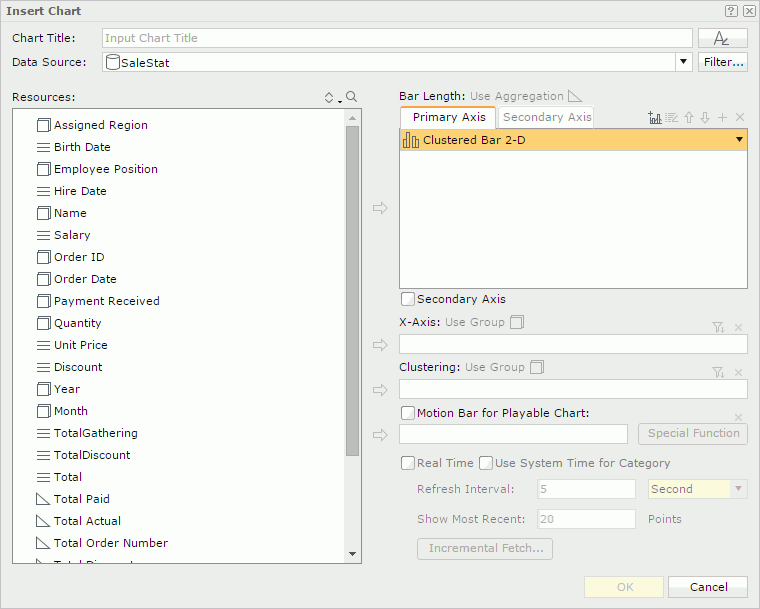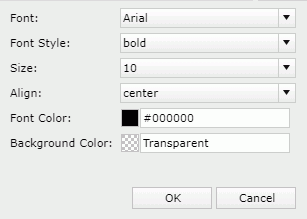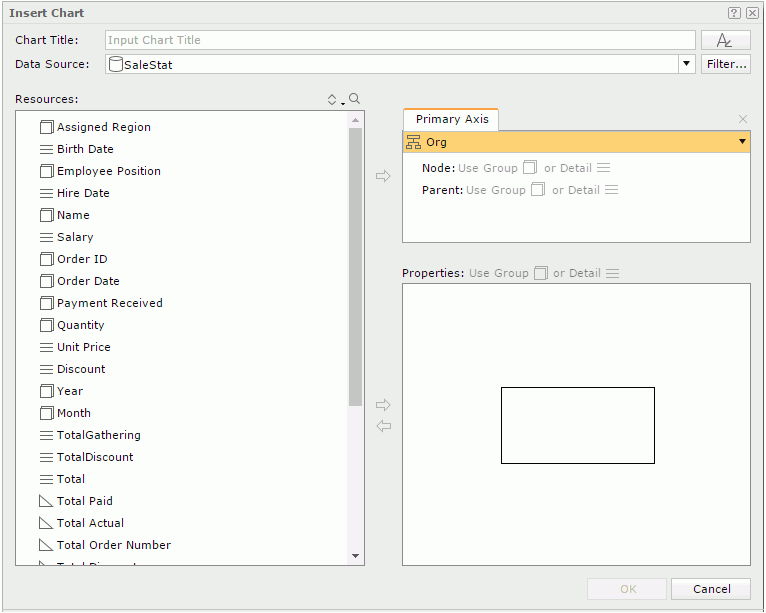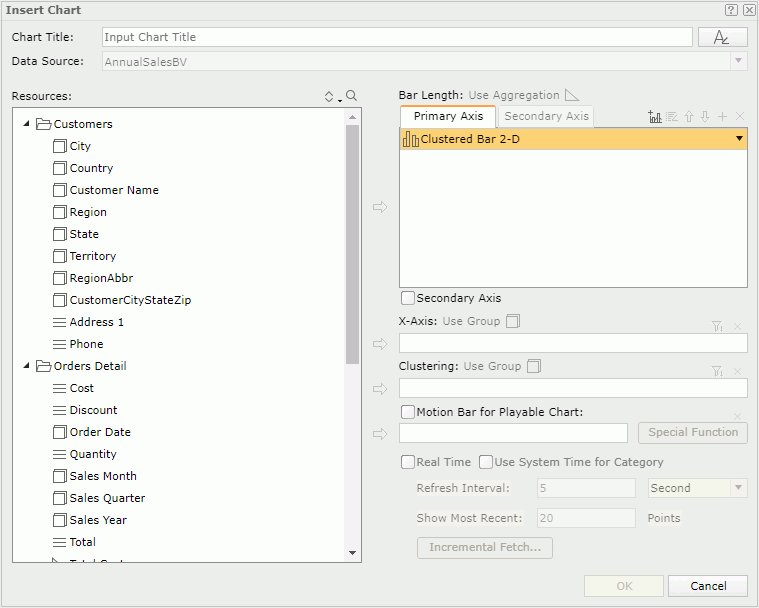Insert Chart
The Insert Chart dialog box is used to define a chart and insert it to the destination, and varies with different chart types: common chart types, organization chart, heat map, and KPI chart.
Report Server displays the dialog box when you do one of the following:
- Drag Chart from the Components panel to the destination.
- Right-click the icon
 of a KPI or the blank area in a KPI that contains no KPI chart, then select Insert KPI Chart from the shortcut menu.
of a KPI or the blank area in a KPI that contains no KPI chart, then select Insert KPI Chart from the shortcut menu.
OK
Inserts a chart in the destination and closes the dialog box.
Cancel
Cancels the insertion and closes the dialog box.

Displays the help document about this feature.

Ignores the setting and closes this dialog box.
For Common Chart Types

Chart Title
Specifies the title of the chart. The title is a special label bound with the chart. Though it can be positioned freely in a report, once you remove the chart from the report, the title will be removed too.

Specifies the font properties of the chart title.
After you select the button, Report Server displays the following dialog box for you to edit the font properties:

- Font
Specifies the font face of the title. - Font Style
Specifies the font style of the title. It can be one of the following: regular, bold, italic, and bold italic. - Size
Specifies the font size of the title. - Align
Specifies the position of the title to be left, right, center, or justify. - Font Color
Specifies the font color of the title. - Background Color
Specifies the background color of the title.To specify a color, click the color image to select a color from the color palette, or select More Colors in the color palette to select a color using the Color Picker dialog.
- OK
Accepts the color settings and closes the dialog. - Cancel
Cancels editing the color and closes the dialog
- Font
Lists all the available font faces that can be selected to apply to the title. - Font Style
Specifies the font style of the title. It can be one of the following: plain, bold, italic, and bold italic. - Size
Specifies the font size of the title. - Align
Specifies the position of the title to be left, right, center or justify. - Font Color
Specifies the font color of the title. - Background Color
Specifies the background color of the title.
Data Source
Specifies the business view in the current catalog on which the chart will be built.
- <Inherit from the Parent>
Specifies to inherit data from the business view used by the parent object. Available only when the chart is to be inserted into any of the following panels in a banded object: banded header panel, banded footer panel, group header panel, and group footer panel.
Filter
Opens the Query Filter dialog box to specify the filter you want to apply to the selected business view.
Resources
Displays the resources that can be added to the chart.

Sorts the view elements in the specified order from the drop-down list. Once a user changes the order, it will be applied to all the resource trees where business view elements are listed for this user.
The order can be one of the following:
- Predefined Order
Sorts the view elements in the order defined in the Business View Editor on Logi Report Designer. - Resource Types
Sorts the view elements by resource type, namely category objects come first, then group objects, then aggregation objects, and at last detail objects. - Alphabetical Order
Sorts the view elements in alphabetical order. Elements that are not in any category will be sorted first, then the categories, and the elements in each category will also be sorted alphabetically.

Launches the search bar to search for view elements.
The following shows the options in the search bar:

- Text box
Type in the text you want to search in the text box and the values containing the matched text will be listed. - X
Closes the search bar. 
Lists more search options.- Highlight All
Specifies whether to highlight all matched text. - Match Case
Specifies whether to search for text that meets the case of the typed text. - Match Whole Word
Specifies whether to search for text that looks the same as the typed text.
- Highlight All

When Highlight All is selected, you can use this button to go to the previous matched text.
When Highlight All is selected, you can use this button to go to the next matched text.

Adds the selected resource to be displayed in the chart.
Value box
The actual name of the box varies with different chart types, for example, it is Bar Length for a clustered bar chart. The box lists the values you want to show in the chart. For a real time chart, the values you add must be of Numeric type and cannot be aggregation objects.
- Primary Axis
Adds a chart type to the primary axis. - Secondary Axis
Adds a chart type to the secondary axis. Active only when the option Secondary Axis is selected. Not available to gauge chart. - X-Axis
Lists the value you want to show on the X axis of the bubble chart. - Y-Axis
Lists the value you want to show on the Y axis of the bubble chart. - Size
Lists the value you want to show as the bubble size.

Adds a combo chart to the Primary Axis or Secondary Axis. Not available to gauge chart.

Opens the Edit Additional Value dialog box to edit the selected additional value.

Moves the selected view element one level up.

Moves the selected view element one level down.

Adds a new pair of Y Axis and Radius for the bubble chart.
Secondary Axis
Specifies whether to show the secondary axis in the chart. Not available to gauge chart.
Category box
The actual name of the box varies with different chart types, for example, it is X-Axis for a clustered bar chart. The box lists the group object  that will be displayed on the category axis of the chart.
that will be displayed on the category axis of the chart.
For a real time chart, if no object is specified on the category axis, Use System Refresh Time will be automatically displayed in the Category text box, namely, the time at which the chart refreshes itself will be used as the category value.
Series box
The actual name of the box varies with different chart types, for example, it is Clustering for a clustered bar chart. The box lists the group object  that will be displayed on the series axis of the chart. Not available to real time chart.
that will be displayed on the series axis of the chart. Not available to real time chart.

Opens the Category Options dialog box or Series Options dialog box to define the sort order of the category or series values and specify the number of the category or series values that will be displayed in the chart.
Motion Bar for Playable Chart
Lists the group object  you want to use as the motion field. A motion field can only be of Integer, Date or Time data type. Available to single bar, bench and bubble chart types only.
you want to use as the motion field. A motion field can only be of Integer, Date or Time data type. Available to single bar, bench and bubble chart types only.
- Special Function
Available only when the motion field is of Date data type. Select it to define the special function.- Field
Displays on which field the special function will be applied. - Function
Specifies the special function to the field. - OK
Accepts the special function settings and leaves the dialog box. - Cancel
Cancels the special function settings and leaves the dialog box.
- Field
Real Time
Specifies to run the chart in real time mode, which means it will be updated automatically using real time data. Available to single bar, bench, line, and area chart types only.
- Use System Time for Category
Specifies to use the time at which the chart refreshes itself as the category value. - Refresh Interval
Specifies the time interval at which the chart will get data and refresh itself automatically. - Show Most Recent N Points
Specifies the number of records that will be kept for the real time data on the chart. - Incremental Fetch
Opens the Unique Key dialog box to configure a unique key for the real time chart.

Removes the selected resource.
For Organization Chart

Chart Title
Specifies the title of the chart. The title is a special label bound with the chart. Though it can be positioned freely in a report, once you remove the chart from the report, the title will be removed too.

Specifies the font properties of the chart title.
Data Source
Specifies the business view in the current catalog on which the chart will be built.
- <Inherit from the Parent>
Specifies to inherit data from the business view used by the parent object. Available only when the chart is to be inserted into any of the following panels in a banded object: banded header panel, banded footer panel, group header panel, and group footer panel.
Filter
Opens the Query Filter dialog box to specify the filter you want to apply to the selected business view.
Resources
Displays the resources that can be added to the chart.

Sorts the view elements in the specified order from the drop-down list. Once a user changes the order, it will be applied to all the resource trees where business view elements are listed for this user.

Launches the search bar to search for view elements.
Value box
- Primary Axis
Select Org from the chart type drop-down menu. - Node
Adds a field from the Resources box which identifies the entity by selecting both the field and Node and then selecting .
. - Parent
Adds a field from the Resources box which shows the "reporting to" relationship among the entity members, that is, which child node field member reports to or belongs to which child node field member, by selecting both the field and Parent and then selecting .
. 
Removes the selected child node or parent field.
Properties
The properties box presents a node model of the org chart. Data fields, labels and images can be inserted into the node as the information about the entity in the org chart, using  . By default all added objects are placed at the left top of the node, you need to adjust their positions and sizes in the node. You can also resize the node.
. By default all added objects are placed at the left top of the node, you need to adjust their positions and sizes in the node. You can also resize the node.
To remove an object from the node, select it and then select  .
.
For Heat Map

Chart Title
Specifies the title of the chart. The title is a special label bound with the chart. Though it can be positioned freely in a report, once you remove the chart from the report, the title will be removed too.

Specifies the font properties of the chart title.
Data Source
Specifies the business view in the current catalog on which the chart will be built.
- <Inherit from the Parent>
Specifies to inherit data from the business view used by the parent object. Available only when the chart is to be inserted into any of the following panels in a banded object: banded header panel, banded footer panel, group header panel, and group footer panel.
Filter
Opens the Query Filter dialog box to specify the filter you want to apply to the selected business view.
Resources
Displays the resources that can be added to the chart.

Sorts the view elements in the specified order from the drop-down list. Once a user changes the order, it will be applied to all the resource trees where business view elements are listed for this user.

Launches the search bar to search for view elements.

Adds the selected field into the Area or Property box.

Removes the selected field from the Area or Property box.
Chart type drop-down list
Displays Heat Map as the selected chart type.
Area
Lists the fields used to group the data to different areas. There should be at least one group. When there are multiple groups, their levels are defined by their positions from top down. The group at the top is of the highest level and the bottom the lowest.
- Color by
Specifies whether to color by a group. 0-n groups can be used as the color-by fields. - Label by
Specifies whether to show the group name in the innermost rectangle. 
Moves the selected group field one level up.
Moves the selected group field one level down.
Opens the Group Options dialog box to define the sort order of the group values and specify the number of the group values that will be displayed in the chart.
Removes the selected group field.
Property
Lists the summary fields used as size-by/color-by or displayed in the innermost rectangle.
- Size by
Specifies to size by one summary or none. - Color by
Specifies to color by one summary or none. - Label by
Specifies whether to show a summary in the innermost rectangle.
For KPI Chart

Chart Title
Specifies the title of the chart. The title is a special label bound with the chart. Though it can be positioned freely in a report, once you remove the chart from the report, the title will be removed too.

Specifies the font properties of the chart title.
Data Source
Specifies the business view in the current catalog on which the chart will be built.
Resources
Displays the resources that can be added to the chart.

Sorts the view elements in the specified order from the drop-down list. Once a user changes the order, it will be applied to all the resource trees where business view elements are listed for this user.

Launches the search bar to search for view elements.

Adds the selected resource to be displayed in the chart.
Value box
The actual name of the box varies with different chart types, for example, it is Bar Length for a clustered bar chart. The box lists the values you want to show in the chart. For a real time chart, the values you add must be of Numeric type and cannot be aggregation objects.
- Primary Axis
Adds a chart type to the primary axis. - Secondary Axis
Adds a chart type to the secondary axis. Active only when the option Secondary Axis is selected.

Adds a combo chart to the Primary Axis or Secondary Axis.

Opens the Edit Additional Value dialog box to edit the selected additional value.

Moves the selected view element one level up.

Moves the selected view element one level down.
Secondary Axis
Specifies whether to show the secondary axis in the chart.
Category box
The actual name of the box varies with different chart types, for example, it is X-Axis for a clustered bar chart. The box lists the group object  that will be displayed on the category axis of the chart.
that will be displayed on the category axis of the chart.
For a real time chart, if no object is specified on the category axis, Use System Refresh Time will be automatically displayed in the Category text box, namely, the time at which the chart refreshes itself will be used as the category value.
Series box
The actual name of the box varies with different chart types, for example, it is Clustering for a clustered bar chart. The box lists the group object  that will be displayed on the series axis of the chart. Not available to real time chart.
that will be displayed on the series axis of the chart. Not available to real time chart.

Opens the Category Options dialog box or Series Options dialog box to define the sort order of the category or series values and specify the number of the category or series values that will be displayed in the chart.
Motion Bar for Playable Chart
Lists the group object  you want to use as the motion field. A motion field can only be of Integer, Date or Time data type. Available to single bar and bench chart types only.
you want to use as the motion field. A motion field can only be of Integer, Date or Time data type. Available to single bar and bench chart types only.
- Special Function
Available only when the motion field is of Date data type. Select it to define the special function.- Field
Displays on which field the special function will be applied. - Function
Specifies the special function to the field. - OK
Accepts the special function settings and leaves the dialog box. - Cancel
Cancels the special function settings and leaves the dialog box.
- Field
Real Time
Specifies to run the chart in real time mode, which means it will be updated automatically using real time data. Available to single bar, bench, line, and area chart types only.
- Use System Time for Category
Specifies to use the time at which the chart refreshes itself as the category value. - Refresh Interval
Specifies the time interval at which the chart will get data and refresh itself automatically. - Show Most Recent N Points
Specifies the number of records that will be kept for the real time data on the chart. - Incremental Fetch
Opens the Unique Key dialog box to configure a unique key for the real time chart.

Removes the selected resource.
 Previous Topic
Previous Topic